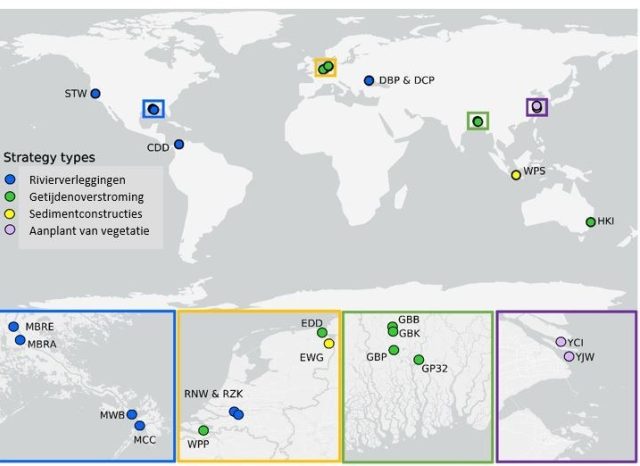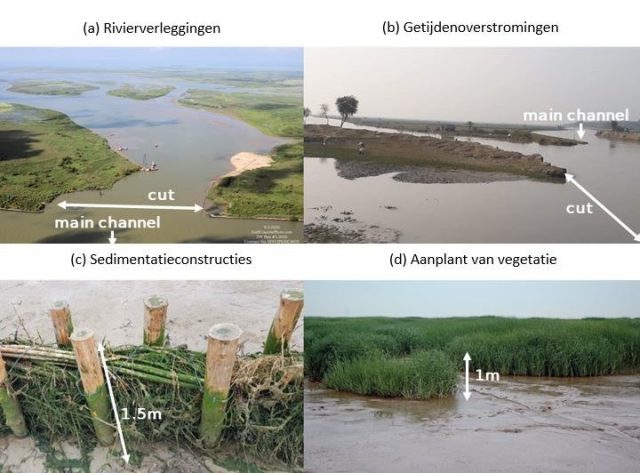Four ways to save deltas from sea level rise
River deltas are drowning in the face of rapidly rising sea-levels. To keep up with sea-level rise, delta land needs to be raised with sand and mud from rivers. But sand and mud supply from rivers is decreasing globally, and doesn’t make it to deltas anymore which causes flooding and land loss.

Utrecht University assembled a team of specialists from countries around the world to solve this problem. Deltares is part of this team. The team investigated and reviewed existing and planned projects that are being explored globally to raise land, so-called ‘Sedimentation Enhancing Strategies’. They found four ways to keep deltas dry. Their research will be published today in Global and Planetary Change. These experts provided local and detailed information on each strategy in order to accurately compare them. In total 21 strategies were compared, with hotspots of activities in the USA, Europe, Bangladesh and China (see Figure 1).
The role of Deltares
Two experts from Deltares, Bas van Maren and Eveline van der Deijl, were part of the team. They conducted research in the Netherlands (Biesbosch and the Eems estuary) and Bangladesh on sediment in different conditions. Eveline van der Deijl: “Not only the presence and resupply of sufficient fine sediment, but also the conditions for long-term retention of this sediment is crucial for the effectiveness of delta recovery by means of sedimentation.” The Biesbosch, for example, was the ideal testing ground because of its depoldering, which aimed at flood safety and nature development. Sediment in coastal areas has also been studied. Bas van Maren: “Fine sediment is often present in abundance in coastal areas, but it is mainly seen as a burden due to the high turbidity or the dredging load. It is wonderful that we are now increasingly experimenting with the beneficial application of sediment worldwide.”

Four ways to keep deltas dry
Four strategies were discovered which are used to save deltas from drowning, ranging from a specific type of sluice gate construction to mangrove restoration. Jana Cox, river-delta researcher and lead author at Utrecht University explains: “All four of these strategies trap sand and mud onto delta lands and raise it above sea level. They are effective and can offset even extreme sea-level rise conditions. Different projects are available at a variety of different scales for deltas of different sizes. Projects can last from ten to a hundred years, depending on what the desired outcome is.”
These processes are (see Figures 2 & 3):
- River diversions: diverting some water and sediment from the main channel of a river into adjacent floodplains
- Tidal flooding: breaching existing dikes and allowing water and sediment to be delivered by the tides to adjacent floodplains
- Sedimentation structures: placing structures (e.g. willow dams) in river channels to trap the existing sediment in the water
- Vegetation planting: planting additional vegetation which traps sediment in its roots


Positive environmental impact at the cost of urban & farming land
The team also assessed the positive and negative environmental impacts and the land-use change that would be required for these strategies. “We found that the strategies generally have many positive environmental and ecosystem impacts: creating new habitats, aquaculture opportunities and create new flood storage spaces, which means the flood risk decreases. However, this comes at the expense of urban or agricultural land in many cases. Available land for implementing strategies is a key aspect in determining possibilities for each individual delta”, explains Cox.
Long-term solutions
The review indicates that low-cost strategies only last 10-15 years and cover only small portions of the delta area. Meanwhile, projects that last for 100+ years are very expensive (multi-million to billions of Euros) but can cover a large amount of the delta area. The combination of several smaller scale projects will also be crucial in deltas where available land is low (e.g. Europe and SE Asia).
However, all projects take several years to plan and implement and require several successful political and legal decision making processes, along with stakeholder engagement to enhance success. So, to offset rapidly rising sea level, decision makers in deltas need to begin testing, planning and pursuing these projects as soon as possible.
“However, all projects combined only encompass 0.1% of delta land” explains Jaap Nienhuis, a delta researcher at Utrecht University and PI of the project. “Strategies are effective in the small areas where they are implemented, but they need to be expanded. Time is running out.”
Article
Cox, J. R., Paauw, M., Nienhuis, J. H., Dunn, F. E., van der Deijl, E., Esposito, C., Goichot, M., Leuven, J.R.F.W., van Maren, D.S., Middelkoop, H., Naffaa, S., Rahman, M., Schwarz, C., Sieben, E., Triyanti, A., & Yuill, B. (2022), ‘A global synthesis of the effectiveness of sedimentation-enhancing strategies for river deltas and estuaries’, Global and Planetary Change, 103796,
